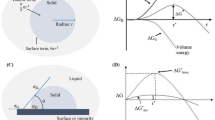Abstract
Bottles and carboys are used for frozen storage and transport of biopharmaceutical formulations under a wide range of conditions. The quality of freezing and thawing in these systems has been questioned due to the formation of heterogeneous ice structures and deformation of containers. This work shows that during freezing of bulk protein solutions, the liquid at the air–liquid interface freezes first, forming an ice crust and enclosing the liquid phase. As the enclosed liquid freezes, internal pressure rises, pushing the liquid phase through the porous ice crust towards the air interface, leading to interfacial stress and protein aggregation. The aggregation of bovine serum albumin was more intense in the foam-like ice mound that was formed at the top, where bubbles were entrapped. This was characterized experimentally with the assistance of magnetic resonance imaging (MRI). An isothermal cover is proposed to prevent the early freezing of the liquid at the air interface, attenuating substantially interfacial stress to proteins and releasing hydrostatic pressure, preserving the shape and integrity of the containers.











Similar content being viewed by others
References
Kolhe P, Goswami S. Bulk protein solution: freeze–thaw process, storage and shipping considerations. In: Warne NW, Mahler H-C, editors. Challenges Protein Prod Dev. 1st ed: Springer International Publishing; 2018. p. 313–36.
Goldstein A, Pohlscheidt M, Loesch J, Mazzarella K, Bieger B, Lam P, et al. Disposable freeze systems in the pharmaceutical industry. Am Pharm Rev. 2012;15(7).
Singh SK, Kolhe P, Wang W, Nema S. Large-scale freezing of biologics-a practitioner’s review. Part two: practical advice. Bioprocess Int. 2009;7:34–42.
Singh SK, Rathore N, McAuley A, Rathore AS. Best practices for the formulation and manufacturing of biotech drug products. BioPharm Int. 2009;22:32–48.
Kilburn D, Malliett A, Wong R. Evaluating single-use frozen storage systems. Am Pharm Rev. 2010;13:12–9.
Jameel F, Padala C, Randolph TW. Strategies for bulk storage and shipment of proteins. In: Jameel F, Hershenson S, editors. Formulation and process development strategies manufacturing biopharmaceuticals. Hoboken: John Wiley & Sons, Inc.; 2010. p. 677–704.
Hauptmann A, Hoelzl G, Loerting T. Distribution of protein content and number of aggregates in monoclonal antibody formulation after large-scale freezing. AAPS PharmSciTech. 2019;20:1–11.
Bezawada A, Thompson M, Cui W. Use of blast freezers in vaccine manufacture. Bioprocess Int. 2011;9:42–51.
Mahdjoub R, Chouvenc P, Seurin MJ, Andrieu J, Briguet A. Sucrose solution freezing studied by magnetic resonance imaging. Carbohydr Res. 2006;341:492–8.
Authelin J-R, Rodrigues MA, Tchessalov S, Singh SK, McCoy T, Wang S, et al. Freezing of biologicals revisited: scale, stability, excipients, and degradation stresses. J Pharm Sci. 2020;109:44–61.
Rodrigues MA, Miller MA, Glass MA, Singh SK, Johnston KP. Effect of freezing rate and dendritic ice formation on concentration profiles of proteins frozen in cylindrical vessels. J Pharm Sci. 2011;100:1316–29.
Rodrigues MA, Balzan G, Rosa M, Gomes D, de Azevedo EG, Singh SK, et al. The importance of heat flow direction for reproducible and homogeneous freezing of bulk protein solutions. Biotechnol Prog. 2013;29:1212–21.
Miller R, Fainerman VB, Makievski AV, Krägel J, Grigoriev DO, Kazakov VN, et al. Dynamics of protein and mixed protein/surfactant adsorption layers at the water/fluid interface. Adv Colloid Interf Sci. 2000;89:39–82.
Gerhardt A, McGraw NR, Schwartz DK, Bee JS, Carpenter JF, Randolph TW. Protein aggregation and particle formation in prefilled glass syringes. J Pharm Sci. 2014;103:1601–12.
Xu Y, Grobelny P, Von Allmen A, Knudson K, Pikal M, Carpenter JF, et al. Protein quantity on the air-solid interface determines degradation rates of human growth hormone in lyophilized samples. J Pharm Sci. 2014;103:1356–66.
Varshney DB, Elliott JA, Gatlin LA, Kumar S, Suryanarayanan R, Shalaev EY. Synchrotron X-ray diffraction investigation of the anomalous behavior of ice during freezing of aqueous systems. J Phys Chem B. 2009;113:6177–82.
Mehta SB, Subramanian S, D’Mello R, Brisbane C, Roy S. Effect of protein cryoconcentration and processing conditions on kinetics of dimer formation for a monoclonal antibody: a case study on bioprocessing. Biotechnol Prog. 2019;35:1–7.
Acknowledgments
The authors would like to thank Cellon (Luxembourg) for providing the PharmaTainers.
Funding
This work was supported by the Portuguese national funds from Portugal 2020, Lisboa 2020, and European Union through Fundo Europeu do Desenvolvimento Regional (Project 17653, Cryocube).
Author information
Authors and Affiliations
Corresponding author
Ethics declarations
Conflict of Interest
SmartFreeZ has filed for intellectual property rights on devices related to the science reported in the manuscript.
Additional information
Publisher’s Note
Springer Nature remains neutral with regard to jurisdictional claims in published maps and institutional affiliations.
Rights and permissions
About this article
Cite this article
Duarte, A., Rego, P., Ferreira, A. et al. Interfacial Stress and Container Failure During Freezing of Bulk Protein Solutions Can Be Prevented by Local Heating. AAPS PharmSciTech 21, 251 (2020). https://doi.org/10.1208/s12249-020-01794-x
Received:
Accepted:
Published:
DOI: https://doi.org/10.1208/s12249-020-01794-x




